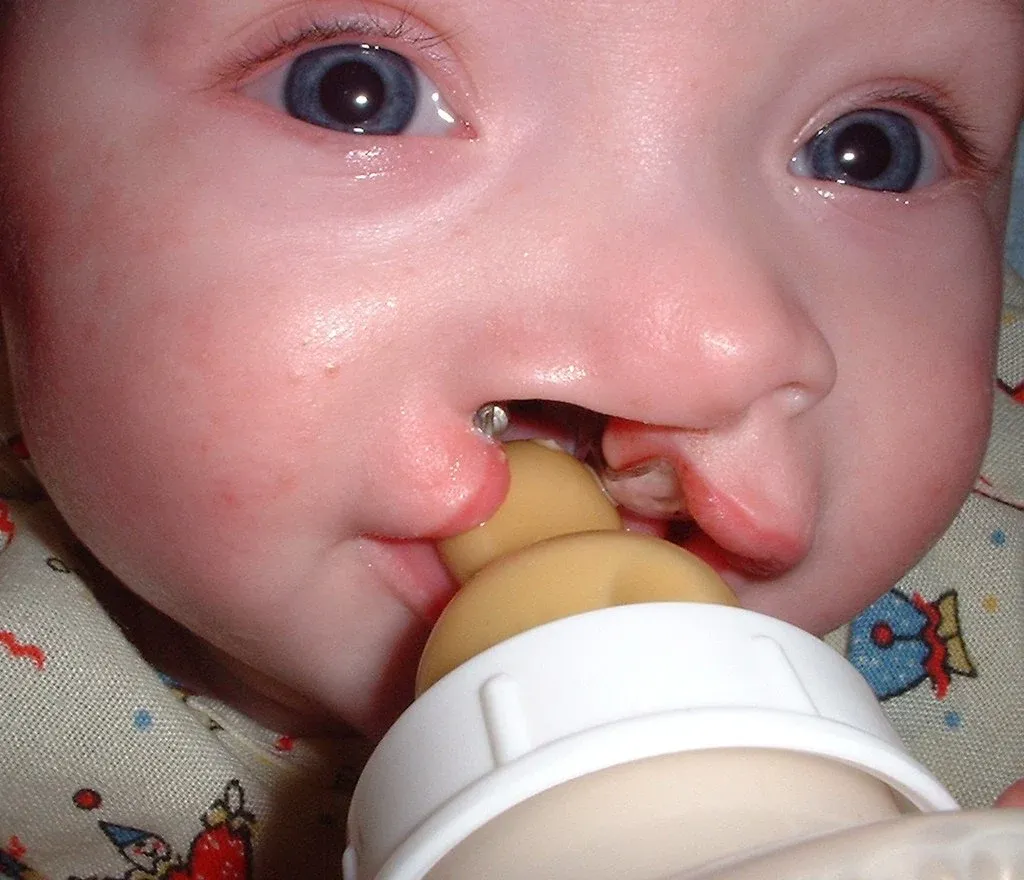The Obturator can help the baby suck stronger and provides firm pressure on the breast. The mother should request that the Obturator be made of a smooth surface, as not to hurt her while breastfeeding
Cleft lip and Cleft palates are among the most common birth defects. While the fetus is developing in the mother’s womb, the lip and palate fuse together. If they do not fuse, this deformity can be minor or severe and affect the entire palate and nose.
Of all babies born with this, a third have only a cleft lip, another third have cleft palates, and the remaining third have both.
Babies with cleft palates are at higher risk of ear and respiratory infections.
What is Cleft Lip?
A cleft lip is an opening between the two sides of the upper lip, as shown.




What is a Cleft Palate?
A cleft palate is an opening between the two sides of the palate, as shown.




Cleft Lip and Palate Treatment

Repair of cleft-lip
It can be done 48 hours after the baby is born.
Repair of Cleft Palate
Cleft palate surgery is usually done within the first or second year of the baby’s life. This allows a period in which the baby’s mouth can mature, but cleft palate plastic surgery should be done before the baby starts talking.
The Impact on Breastfeeding
During breastfeeding, the lip and palate help create the suction necessary to pull the milk from the breast. If the lip and palate are not formed properly, the suction is insufficient, and in some cases, it can be nearly impossible to breastfeed.
A cleft palate can cause milk to flow into the nasal passages, which may cause choking while breastfeeding.
Babies with only a cleft lip may have a better chance at breastfeeding. The mother can sometimes close the hole to make a seal with her hands while her baby is breastfeeding.
Unfortunately, some babies may need to drink via alternative methods until their cleft has been fixed.
Cleft Lip Symptoms
Common breastfeeding problems encountered.
• Babies with cleft lip/palate usually take much longer to feed.
• Babies with cleft lip/palate problems usually need supplementation, preferably the mother’s milk or donor milk, if possible.
Why is Breast Milk Important?
• Breast milk supports the immune system, reducing the incidences of ear infections (babies with clefts are more prone to ear and respiratory infections).
• Breast milk will help prevent hearing, speech, and language problems linked with ear infections. (Cleft palate speech therapy is often needed).
• Surgery on its own comes with the risk of infections, and breast milk can help protect the baby from these infections.
Making Breastfeeding Easier
• It is imperative that a lactation consultant helps the breastfeeding relationship.
• Trying different breastfeeding positions can help the mother find one that is comfortable and easiest.
• Upright breastfeeding positions can help keep the milk from running into the baby’s nose.
• Mom may need to support her baby’s jaw and chin while latching and keeping a position at the breast.
• Using a Palatal Obturator: This appliance fits into the baby’s mouth to shape the palate. The Obturator can help the baby suck stronger and provides firm pressure on the breast. The mother should request that the Obturator be made of a smooth surface so as not to hurt her while breastfeeding.
Breastfeeding Cleft Palate / Lip Babies – Other Tips
• Keep an eye on the milk transfer. The signs that your baby is getting in enough milk.
• A mother should express her milk after feedings to drain the breast well. This will help stimulate milk production. She should use a hospital-grade, electric, double-action breast pump if possible.
• Keep your baby accustomed to the breast so that your baby is more likely to breastfeed after surgery.
Supplementing a Baby With a Cleft Lip/Palate
• Haberman bottle: This helps regulate the milk flow into the baby’s mouth.
• Cleft palate nursers: These are bottles for babies with cleft palates.
• An SNS “supplemental nursing system” can be used to help supplement a baby while continuing to breastfeed at the same time.
Cleft Lip and Palate Causes / Prevention
Can cleft lip/palate be avoided during pregnancy?
• Mothers should take at least 400 mcg of Folic acid daily, especially during the first trimester.
• Mothers should avoid certain drugs such as epilepsy medication, steroids, anti-inflammatory meds, alcohol, and cocaine.


